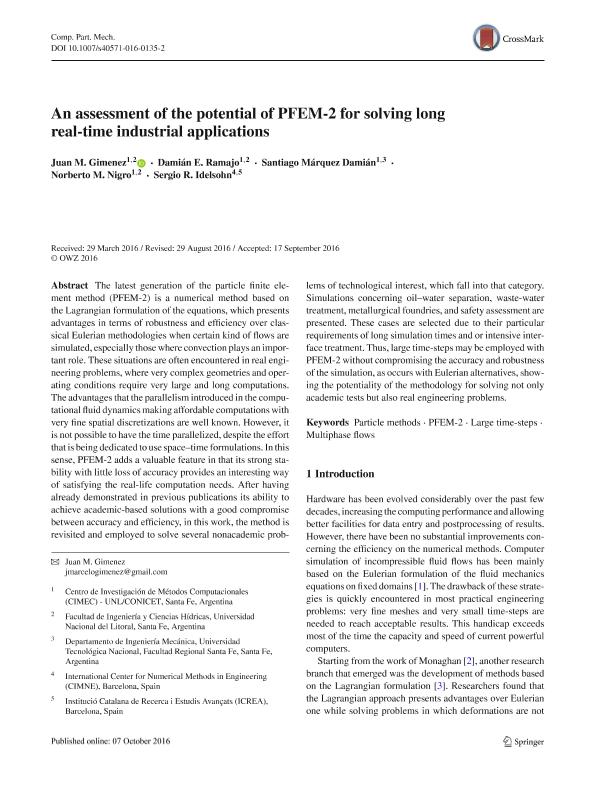Artículo
An assessment of the potential of PFEM-2 for solving long real-time industrial applications
Gimenez, Juan Marcelo ; Ramajo, Damian Enrique
; Ramajo, Damian Enrique ; Marquez Damian, Santiago
; Marquez Damian, Santiago ; Nigro, Norberto Marcelo
; Nigro, Norberto Marcelo ; Idelsohn, Sergio Rodolfo
; Idelsohn, Sergio Rodolfo
 ; Ramajo, Damian Enrique
; Ramajo, Damian Enrique ; Marquez Damian, Santiago
; Marquez Damian, Santiago ; Nigro, Norberto Marcelo
; Nigro, Norberto Marcelo ; Idelsohn, Sergio Rodolfo
; Idelsohn, Sergio Rodolfo
Fecha de publicación:
07/2017
Editorial:
Springer International Publishing
Revista:
Computational Particle Mechanics
ISSN:
2196-4378
e-ISSN:
2196-4386
Idioma:
Inglés
Tipo de recurso:
Artículo publicado
Clasificación temática:
Resumen
The latest generation of the particle finite element method (PFEM-2) is a numerical method based on the Lagrangian formulation of the equations, which presents advantages in terms of robustness and efficiency over classical Eulerian methodologies when certain kind of flows are simulated, especially those where convection plays an important role. These situations are often encountered in real engineering problems, where very complex geometries and operating conditions require very large and long computations. The advantages that the parallelism introduced in the computational fluid dynamics making affordable computations with very fine spatial discretizations are well known. However, it is not possible to have the time parallelized, despite the effort that is being dedicated to use space–time formulations. In this sense, PFEM-2 adds a valuable feature in that its strong stability with little loss of accuracy provides an interesting way of satisfying the real-life computation needs. After having already demonstrated in previous publications its ability to achieve academic-based solutions with a good compromise between accuracy and efficiency, in this work, the method is revisited and employed to solve several nonacademic problems of technological interest, which fall into that category. Simulations concerning oil–water separation, waste-water treatment, metallurgical foundries, and safety assessment are presented. These cases are selected due to their particular requirements of long simulation times and or intensive interface treatment. Thus, large time-steps may be employed with PFEM-2 without compromising the accuracy and robustness of the simulation, as occurs with Eulerian alternatives, showing the potentiality of the methodology for solving not only academic tests but also real engineering problems.
Palabras clave:
Large Time-Steps
,
Multiphase Flows
,
Particle Methods
,
Pfem-2
Archivos asociados
Licencia
Identificadores
Colecciones
Articulos(CIMEC)
Articulos de CENTRO DE INVESTIGACION DE METODOS COMPUTACIONALES
Articulos de CENTRO DE INVESTIGACION DE METODOS COMPUTACIONALES
Articulos(INTEC)
Articulos de INST.DE DES.TECNOL.PARA LA IND.QUIMICA (I)
Articulos de INST.DE DES.TECNOL.PARA LA IND.QUIMICA (I)
Citación
Gimenez, Juan Marcelo; Ramajo, Damian Enrique; Marquez Damian, Santiago; Nigro, Norberto Marcelo; Idelsohn, Sergio Rodolfo; An assessment of the potential of PFEM-2 for solving long real-time industrial applications; Springer International Publishing; Computational Particle Mechanics; 4; 3; 7-2017; 251-267
Compartir
Altmétricas



